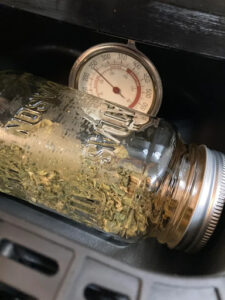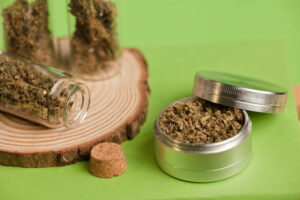In today’s households, the hot air cooker has gained considerable popularity, offering a delightful and healthier method to prepare a range of fried or grilled dishes. It eliminates concerns about oily splatters while ensuring the well-being of your health. Can you decarb weeds in an air fryer? Let’s delve into this inquiry. Furthermore, decarboxylating weed is also a crucial step before its usage. But can you effectively perform decarboxylation using an air fryer? Let’s explore this question while emphasizing the importance of cautious temperature control and mindful usage to prevent waste.
Is Decarbing Weed Possible in an Air Fryer?
You can decarboxylate weed using a hot air cooker, but following the correct steps is essential to ensure effectiveness. Proper temperature control is critical. Start by setting your air fryer to 250 degrees Fahrenheit (120 degrees Celsius). Using excessive heat can damage the decarboxylation process. The recommended duration for decarbing is up to one hour. To enhance the process, consider stirring the weed halfway through and continuing for an additional 30 minutes.
Alternatively, a more straightforward method involves placing the weeds in the air fryer basket and cooking it at 240 degrees Fahrenheit (115 degrees Celsius) for 10 minutes. Subsequently, allow the weed to cool down before incorporating it into recipes that require decarboxylated cannabis.
For the first technique, ensure an even weed distribution in the hot air cooker basket. Cook for approximately 20-30 minutes, intermittently stirring to achieve a uniform browning and crisp texture. Always let the decarbed weed cool before using it.
Using these two distinct approaches, you can effectively decarb weed using an hot air cooker. This offers convenience and opens up possibilities for creating flavorful and health-conscious culinary delights.
Optimal Temperature and Cooking Times for Precise Weed Decarb
Achieving perfect decarboxylation of weed relies heavily on precise temperature and timing. Without these necessary factors, the process can quickly go wrong, resulting in burned or badly decarbed weed.
Crucial Temperature Range: Decarboxylation of weed is best achieved within the temperature range of 220 to 250 degrees Fahrenheit. However, it’s critical to acknowledge that individual cannabinoids and terpenes necessitate distinct temperature parameters.
Temperature and Time Guidelines for Specific Compounds: THCa necessitates decarboxylation temperatures of 220 to 240 degrees Fahrenheit, requiring 30 to 45 minutes. In difference, CBDa demands a lengthier cooking time of up to 90 minutes within the same temperature range.
Decarboxylation Time Variability: The duration required for decarboxylation hinges on factors such as the type of plant material and the quantity being processed. Commonly, longer cooking times at lower temperatures play a pivotal role in maintaining the full spectrum of valuable compounds, maximizing their health benefits.
Do You Need to Grind Weed Before Decarboxylation?
While some formulae recommend grinding weed before the decarboxylation process, it’s not a recommended practice. Grinding weed before decarboxylation can lead to the loss of terpenes within the trichomes. Trichomes are focused at the base of the Kief collection chamber.
It’s enough to break the weed into a relatively fine texture to preserve these compounds to the fullest extent possible. This can be easily achieved using your fingers. Hence, grinding is not required at all.
How to decarb weeds in an air fryer?
Decarboxylating weed with an air fryer offers a more straightforward method than an oven.
Essential Tools and Ingredients:
- An hot air cooker
- Aluminum foil
- Weed plant
- Oven-safe baking dish
- Cheesecloth or mesh filter
Step-by-Step Guide:
- Set Temperature and Time: Set the hot air cooker to 250 degrees Fahrenheit and adjust the cooking time to 60 minutes.
- Prepare the Plant Material: Unlike grinding, which could lead to terpene loss, gently break down the plant material into small to medium-sized pieces using your fingers.
- Arrange the Weed: Create a thin layer of the broken-down weed within the oven-safe baking dish.
- Cover with Foil: Shield the baking dish using aluminum foil, puncturing small holes throughout. This facilitates the release of air during the decarboxylation process.
- Place in the Air Fryer: Position the weed-filled dish in the basket. Pause the hot air cooker at the 30-minute mark or halfway through. Gently shake the baking dish to evenly distribute the weed, promoting consistent decarboxylation.
- Check for Color: Take it out of the air fryer once the weed turns a rich golden brown.
- Cooling Down: Allow the weed to cool at room temperature, which generally takes about thirty minutes.
- Finalizing the Process: After the cooling period, the decarboxylation process concludes.
Using an hot air cooker simplifies the decarboxylation process with these straightforward steps, streamlining the procedure compared to traditional oven methods.
How can you decarb weeds without smell?
During the decarboxylation process, an unpleasant odor is released, mainly when working with more than a few grams. This smell can become quite substantial.
However, there are several approaches you can take to reduce the odor.
- Oven Bag Method: One effective way is by using an oven bag. Place the weed inside the bag and then into the air fryer. Oven bags are safe for use with air fryers. Ensure you leave a portion of the bottom surface exposed rather than completely covering it.
- Mason Jar Technique: Another option is to use a mason jar in the hot air cooker. Ensure that the pots you use are heat-proof. Remember that this method is suitable for smaller batches at a time.
By employing these methods, you can significantly mitigate the pungent odor that typically accompanies the decarboxylation of weed.
Consequences of Over-Decarboxylating Weed
As previously emphasized, time and temperature are critical factors in the decarboxylation process. So, what occurs when weed is decarbed for an extended period? Several outcomes should be anticipated.
- Flavor Loss: Primarily, the flavorful characteristics that contribute to the enjoyable taste of the weed will diminish. In fact, excessively decarbed weed might resemble and taste similar to burnt food.
- Aroma and Texture Impact: Furthermore, you can expect a negative impact on the aroma and the overall consistency of the weed. These attributes could be compromised when over-decarboxylating.
- THC Degradation: A critical component of weed is THC, which contributes to its potency and appeal. Excessive decarboxylation can lead to the significant breakdown and destruction of THC and CBD compounds within the weed, potentially rendering them ineffective or significantly reduced in potency.
It’s essential to strike the right balance during the decarboxylation process to preserve the weed’s desired flavors, aromas, and potency.
What are the advantages of using an air fryer to decard weeds?
Using an air fryer to decarboxylate weed offers several benefits compared to using an oven. There are some of the advantages:
- Faster Process: Air fryers typically heat up faster than ovens, allowing you to start the decarboxylation process sooner.
- Even Heating: Hot air cookers use a convection mechanism that evenly circulates hot air around the weed. This can result in more consistent decarboxylation throughout the batch.
- Precise Temperature Control: Many hot air cookers offer particular temperature settings, allowing you to set the exact temperature required for decarboxylation.
- Energy Efficiency: Air fryers are generally more energy-efficient than ovens, which can be advantageous for longer decarboxylation times.
- Less Odor: While there will still be an odor when decarboxylating weed, using an hot air cooker with a closed lid might contain the smell better than an oven, which could be helpful if you’re concerned about odors.
- Smaller Batch Size: Air fryers are typically smaller than ovens, which can be beneficial if you decarboxylate a small amount of weed.
- Ease of Use: Hot air cookers often come with presets and timers, making setting the correct cooking time and temperature convenient.
- Reduced Risk of Burning: An air fryer’s even heating and controlled environment might reduce the risk of accidentally burning the weed during the decarboxylation process.
However, it’s important to note that using a hot air cooker for decarboxylation might require some trial and error to find the optimal settings for your specific batch of weed, as different air fryer models may vary heat distribution and performance.
Is there any disadvantage to using an air fryer to decard weeds?
While using a hot air cooker for decarboxylating weed can offer several advantages, some disadvantages should be considered:
- Higher Initial Cost: Air fryers can be more expensive than other cooking tools, which might not be cost-effective if you only use them for decarboxylation.
- Small Size and Capacity: Most have a hot air cooker limited capacity due to their small size, making it challenging to decarboxylate larger quantities of weed at once.
- Temperature Control Challenges: Some air fryers might have less precise temperature control than ovens, which could impact the accuracy of the decarboxylation process.
- Limited Applicability: Not all weed strains might be suitable for decarboxylation in an air fryer. Experimentation might be required to determine if your specific weed works well with this method.
- Skill and Experience: Using a hot air cooker effectively for decarboxylation requires skill and experience to ensure that you achieve the desired results without under-decarboxylating or over-decarboxylating the weed.
- Cleaning and Maintenance: Cleaning the minor components of an air fryer can be more time-consuming than other decarboxylation methods.
- Uniformity of Decarboxylation: An air fryer’s small size and air circulation might lead to uneven decarboxylation if not carefully monitored and adjusted.
- Noise and Odor: Hot air cookers can generate noise and release odors during operation, which could be a concern depending on your living situation.
In conclusion, while air fryers offer convenience, there might be better choices for some. It’s essential to weigh the pros and cons and determine if an air fryer aligns with your needs and preferences for decarboxylating weed.
Related posts:

Denis Cotter is an Irish celebrity chef, author and proprietor of the acclaimed vegetarian Café Paradiso restaurant in Cork City. He has featured on the RTÉ One television series Guerrilla Gourmet.

